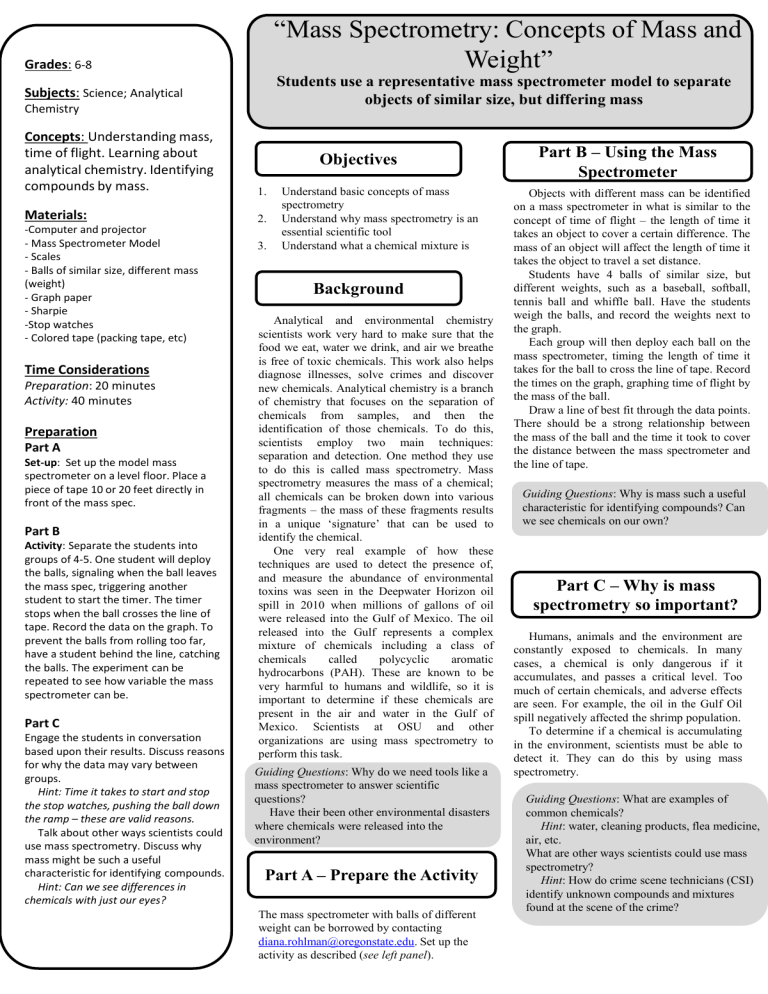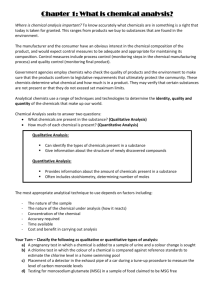PPT

Grades:
6-8
Subjects:
Science; Analytical
Chemistry
Concepts: Understanding mass, time of flight. Learning about analytical chemistry. Identifying compounds by mass.
Materials:
-Computer and projector
- Mass Spectrometer Model
- Scales
- Balls of similar size, different mass
(weight)
- Graph paper
- Sharpie
-Stop watches
- Colored tape (packing tape, etc)
Time Considerations
Preparation: 20 minutes
Activity: 40 minutes
Preparation
Part A
Set-up: Set up the model mass spectrometer on a level floor. Place a piece of tape 10 or 20 feet directly in front of the mass spec.
Part B
Activity: Separate the students into groups of 4-5. One student will deploy the balls, signaling when the ball leaves the mass spec, triggering another student to start the timer. The timer stops when the ball crosses the line of tape. Record the data on the graph. To prevent the balls from rolling too far, have a student behind the line, catching the balls. The experiment can be repeated to see how variable the mass spectrometer can be.
Part C
Engage the students in conversation based upon their results. Discuss reasons for why the data may vary between groups.
Hint: Time it takes to start and stop the stop watches, pushing the ball down the ramp – these are valid reasons.
Talk about other ways scientists could use mass spectrometry. Discuss why mass might be such a useful characteristic for identifying compounds.
Hint: Can we see differences in chemicals with just our eyes?
“Mass Spectrometry: Concepts of Mass and
Weight”
Students use a representative mass spectrometer model to separate objects of similar size, but differing mass
Objectives
1.
Understand basic concepts of mass spectrometry
2.
Understand why mass spectrometry is an essential scientific tool
3.
Understand what a chemical mixture is
Background
Analytical and environmental chemistry scientists work very hard to make sure that the food we eat, water we drink, and air we breathe is free of toxic chemicals. This work also helps diagnose illnesses, solve crimes and discover new chemicals. Analytical chemistry is a branch of chemistry that focuses on the separation of chemicals from samples, and then the identification of those chemicals. To do this, scientists employ two main techniques: separation and detection. One method they use to do this is called mass spectrometry. Mass spectrometry measures the mass of a chemical; all chemicals can be broken down into various fragments – the mass of these fragments results in a unique ‘signature’ that can be used to identify the chemical.
One very real example of how these techniques are used to detect the presence of, and measure the abundance of environmental toxins was seen in the Deepwater Horizon oil spill in 2010 when millions of gallons of oil were released into the Gulf of Mexico. The oil released into the Gulf represents a complex mixture of chemicals including a class of chemicals called polycyclic aromatic hydrocarbons (PAH). These are known to be very harmful to humans and wildlife, so it is important to determine if these chemicals are present in the air and water in the Gulf of
Mexico.
Scientists at OSU and other organizations are using mass spectrometry to perform this task.
Guiding Questions : Why do we need tools like a mass spectrometer to answer scientific questions?
Have their been other environmental disasters where chemicals were released into the environment?
Part A – Prepare the Activity
The mass spectrometer with balls of different weight can be borrowed by contacting diana.rohlman@oregonstate.edu
. Set up the activity as described ( see left panel ).
Part B – Using the Mass
Spectrometer
Objects with different mass can be identified on a mass spectrometer in what is similar to the concept of time of flight – the length of time it takes an object to cover a certain difference. The mass of an object will affect the length of time it takes the object to travel a set distance.
Students have 4 balls of similar size, but different weights, such as a baseball, softball, tennis ball and whiffle ball. Have the students weigh the balls, and record the weights next to the graph.
Each group will then deploy each ball on the mass spectrometer, timing the length of time it takes for the ball to cross the line of tape. Record the times on the graph, graphing time of flight by the mass of the ball.
Draw a line of best fit through the data points.
There should be a strong relationship between the mass of the ball and the time it took to cover the distance between the mass spectrometer and the line of tape.
Guiding Questions : Why is mass such a useful characteristic for identifying compounds? Can we see chemicals on our own?
Part C – Why is mass spectrometry so important?
Humans, animals and the environment are constantly exposed to chemicals. In many cases, a chemical is only dangerous if it accumulates, and passes a critical level. Too much of certain chemicals, and adverse effects are seen. For example, the oil in the Gulf Oil spill negatively affected the shrimp population.
To determine if a chemical is accumulating in the environment, scientists must be able to detect it. They can do this by using mass spectrometry.
Guiding Questions : What are examples of common chemicals?
Hint : water, cleaning products, flea medicine, air, etc.
What are other ways scientists could use mass spectrometry?
Hint : How do crime scene technicians (CSI) identify unknown compounds and mixtures found at the scene of the crime?








